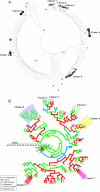Patterns and characteristics of hepatitis C transmission clusters among HIV-positive and HIV-negative individuals in the Australian trial in acute hepatitis C
- PMID: 21282185
- PMCID: PMC3106259
- DOI: 10.1093/cid/ciq200
Patterns and characteristics of hepatitis C transmission clusters among HIV-positive and HIV-negative individuals in the Australian trial in acute hepatitis C
Abstract
Background: Injecting drug users remain the population at greatest risk of acquiring hepatitis C virus (HCV) infection, although a recent increase in cases of sexually transmitted HCV infection has been observed among human immunodeficiency virus (HIV)-infected individuals. The extent to which these separate epidemics overlap is unknown.
Methods: The Australian Trial in Acute Hepatitis C (ATAHC) enrolled 163 individuals (29% of whom were HIV infected) with recent HCV infection. E1/HVR1 sequences were used to construct phylogenetic trees demonstrating monophyletic clusters or pairs, and viral epidemic history and phylogeography were assessed using molecular clock analysis. Individual clusters were characterized by clinical and demographic characteristics.
Results: Transmission through injection drug use occurred for 73% of subjects, with sexual transmission occurring for 18% (92% of whom were HIV infected). Among 112 individuals with available E1/HVR1 sequences, 23 (20%) were infected with a strain of HCV identical to that of another subject, comprising 4 homologous clusters and 3 monophyletic pairs, the majority of which (78%) were HIV infected. Clusters contained individuals with both injection drug use-related and sex-related acquisition, and in all clusters (except for 1 female HIV-uninfected pair), individuals identified as men who have sex with men, irrespective of HIV status.
Conclusions: This large unique study of HIV-infected and HIV-uninfected individuals with recently acquired HCV infection demonstrates that clustering is common in the HIV-infected population and that it occurred almost invariably among men who have sex with men, irrespective of the actual mode of acquisition. These findings suggest the coexistence of both injection drug use and sexual risk behaviors for individuals in the same social networks and have implications for the development of public health messages. Clinical trial registration. NCT00192569.
Figures

References
-
- Maher L, Li J, Jalaludin B, Chant KG, Kaldor JM. High hepatitis C incidence in new injecting drug users: a policy failure? Aust N Z J Public Health. 2007;31:30–5. - PubMed
-
- Robotin MC, Copland J, Tallis G, et al. Surveillance for newly acquired hepatitis C in Australia. J Gastroenterol Hepatol. 2004;19:283–8. - PubMed
-
- Cochrane A, Searle B, Hardie A, et al. A genetic analysis of hepatitis C virus transmission between injection drug users. J Infect Dis. 2002;186:1212–1. - PubMed

